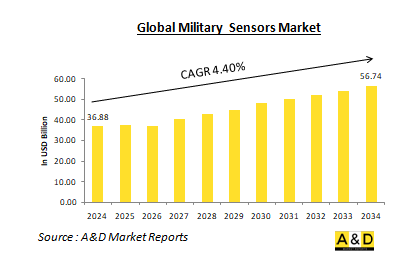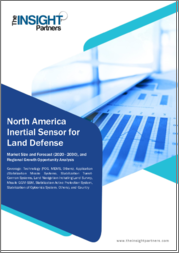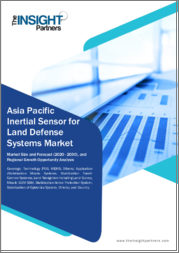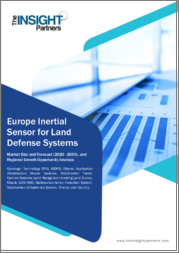
|
시장보고서
상품코드
1516955
세계의 군용 센서 시장(2024-2034년)Global Military Sensors Market 2024-2034 |
||||||
세계 군용 센서 시장 규모는 2024년 368억 8,000만 달러로 추정되며, 예측 기간(2024-2034년) 동안 4.40%의 연평균 성장률(CAGR)로 2034년까지 567억 4,000만 달러로 성장할 것으로 예상됩니다.

군용 센서 시장 개요
군용 센서는 현대 전장에서 상황 인식, 목표 포착 및 의사 결정의 기초가 되는 중요한 구성요소입니다. 이 장치들은 빛, 소리, 열, 압력, 가속도, 자기장, 방사선과 같은 물리량을 감지하고 측정하여 처리 및 분석할 수 있는 전기 신호로 변환합니다. 무인항공기(UAV)에서 잠수함에 이르기까지 군용 센서는 거의 모든 플랫폼과 시스템에 내장되어 있습니다.
세계 군용 센서 시장에서 기술의 영향력
기술의 발전은 군용 센서의 능력에 혁명을 일으켜 전례 없는 수준의 정보, 감시 및 정찰(ISR)을 가능하게 했습니다. 이러한 변화의 주요 원동력 중 하나는 소형화다. 더 작고, 더 가볍고, 더 에너지 효율적인 센서에 대한 끊임없는 추구는 웨어러블 기기 및 초소형 비행체(MAV)를 포함한 다양한 플랫폼에 센서를 통합하는 결과를 가져왔습니다. 이러한 소형화 덕분에 이전에는 접근하기 어려웠던 다양한 환경에 센서를 배치할 수 있게 되어 운영의 유연성과 효율성을 높일 수 있게 되었습니다. 감도의 향상도 중요한 발전입니다. 재료 과학과 센서 설계의 발전으로 더욱 민감한 센서가 개발되어 표적과 위협을 조기에 발견할 수 있게 되었습니다. 이러한 민감도 향상은 잠재적 위험이 확대되기 전에 식별할 수 있어 다양한 시나리오에서 군사력에 결정적인 우위를 가져다 줄 수 있습니다. 데이터 융합 또한 군용 센서의 발전에 중요한 역할을 하고 있습니다. 여러 센서와 플랫폼의 데이터를 결합할 수 있는 능력은 상황 인식을 크게 향상시켰습니다. 고급 알고리즘과 컴퓨팅 파워는 서로 다른 출처의 정보를 융합하여 전장에 대한 포괄적이고 통합된 이미지를 생성할 수 있습니다. 이러한 전체적인 시각은 효과적인 의사결정과 작전 계획에 필수적입니다. 인공지능(AI)은 센서 기술에 또 다른 혁명을 가져왔으며, AI 기반 센서 시스템은 방대한 양의 데이터를 실시간으로 분석하여 인간 운영자가 감지하기 어려운 패턴과 이상 징후를 식별할 수 있습니다. 이를 통해 보다 신속한 의사결정을 내릴 수 있고, 목표물 인식이 향상되며, 전반적인 임무의 효율성과 운영 효율성을 높일 수 있습니다.
군용 센서 시장의 주요 촉진요인
여러 가지 요인이 군용 센서의 개발과 채택을 촉진하고 있습니다. 테러리즘과 비대칭 전쟁의 위협이 증가함에 따라 숨겨진 위협을 감지하고 추적할 수 있는 첨단 센서의 필요성이 강조되고 있습니다. 이러한 시나리오에서 첨단 센서는 숨겨진 위험을 식별하고 무력화하여 대테러 작전 및 비전통적 위협에 대한 대응의 효율성을 높이는 데 중요한 역할을 할 수 있습니다. 정밀 타격 능력에 대한 수요도 센서 기술의 발전에 박차를 가하고 있습니다. 정밀타격을 지원하기 위해서는 더 높은 해상도와 정확도를 가진 센서가 필수적입니다. 이러한 첨단 센서는 보다 정확한 조준을 가능하게 하고, 부수적인 피해를 줄여 군사 작전의 효과를 높일 수 있습니다.
무인자동차, 로봇 등 자율 시스템에 대한 의존도가 높아지면서 첨단 센서의 필요성이 더욱 커지고 있습니다. 자율 시스템에는 내비게이션, 장애물 회피, 목표물 포착을 위한 첨단 센서가 필요합니다. 이러한 센서는 무인 플랫폼이 다양한 환경에서 효과적이고 안전하게 작동하고 다양한 군사적 용도를 지원할 수 있도록 보장합니다. 사이버 보안에 대한 우려도 군용 센서 개발에 영향을 미치는 중요한 요인입니다. 민감한 센서 데이터를 사이버 공격으로부터 보호하는 것은 센서 시스템의 무결성과 신뢰성을 유지하는 데 필수적입니다. 센서 데이터를 보호하고 군사 작전이 안전하고 중단되지 않도록 하기 위해서는 고도의 암호화 및 사이버 보안 조치가 필요합니다.
군용 센서 시장의 지역별 동향
군용 센서의 개발 및 배치는 지역마다 크게 다릅니다. 북미와 유럽은 성숙한 기술과 무인 시스템 및 네트워크 중심 전쟁에 초점을 맞춘 덕분에 센서 혁신의 최전선에 서 있습니다. 이들 지역에서 개발된 첨단 센서 능력은 첨단 기술을 군사 작전에 통합하는 데 있어 선도적인 위치를 반영하고 있습니다. 아시아태평양에서는 중국과 인도와 같은 국가들의 급속한 경제 성장과 국방 예산 증가로 인해 센서 기술에 대한 막대한 투자가 이루어지고 있습니다. 이들 국가는 지역 안보 과제에 대한 대응 능력을 강화하고 국방 인프라를 강화하기 위해 고유한 센서 역량 개발에 집중하고 있습니다. 복잡한 안보 환경이 특징인 중동 지역에서는 첨단 센서에 대한 수요가 증가하고 있습니다. 이러한 수요의 배경에는 효과적인 국경 감시, 대테러 활동 및 정보 수집의 필요성이 있습니다. 이 지역에 첨단 센서를 배치하면 다양한 국가의 다각적인 안보 우려와 운영 요구 사항을 해결하는 데 도움이 될 수 있습니다. 러시아는 경제적 어려움에도 불구하고 미사일 방어 및 조기 경보 시스템에 중점을 둔 센서 기술에 대한 투자를 계속하고 있습니다. 이러한 투자는 견고한 방어 능력을 유지하고 잠재적 위협을 조기에 발견하고 대응하기 위한 러시아의 전략적 우선순위를 반영합니다. 이처럼 군용 센서는 현대 전쟁에서 없어서는 안 될 필수적인 도구가 되었습니다. 기술 발전의 빠른 속도는 전장을 완전히 바꾸고 있으며, 군대가 그 어느 때보다 빠르게 정보를 수집하고 처리할 수 있게 해주고 있습니다. 센서 기술이 계속 발전함에 따라 센서가 미래의 분쟁을 형성하고 군사적 효과를 높이는 데 더욱 중요한 역할을 할 것임은 의심의 여지가 없습니다.
군용 센서의 주요 프로그램
호주 정부는 국방부가 사용할 우주 기반 전술 센서 시스템을 제공하기 위해 재향군인이 운영하는 남호주 기업 Asension에 435만 달러를 지불하기로 합의했습니다. 이번 계약은 국방혁신허브(Defence Innovation Hub)를 통해 체결된 것으로, 국방부의 경쟁 우위를 강화하기 위해 국방 산업과 협력하고 호주 전역의 창의성을 활용하겠다는 정부의 의지를 보여주는 것입니다.
벨기에와 독일을 대표하여 공동군사협력기구(OCCAR)는 HENSOLDT Optronics와 THEON SENSORS로 구성된 컨소시엄과 쌍안경 야간투시경 고글에 대한 계약 수정에 서명했습니다. 수억 달러 규모의 이번 계약 수정으로 독일군에 마이크론 나이트비전 고글 2만 개를 추가로 공급할 수 있게 되었으며, 납기 또한 단축될 것으로 보입니다. 새로 설립된 합작회사 HENSOLDT Theon Night Vision이 후속 계약을 이행할 예정입니다.
프랑스 국무부는 MQ-9 무인항공기용 통신 정보 센서 포드 시스템을 최대 8대, 약 8,800만 달러에 프랑스에 매각합니다. 국방안보협력국에 따르면 이번 대외군사판매 가능성은 7,100만 달러 상당의 5개 포드 제품군 및 관련 장비에 대한 프랑스 정부와의 사전 계약을 증가시킬 것이라고 밝혔습니다. 소모품 및 액세서리, 엔지니어링, 기술, 후방 지원 서비스, 지상 처리 장비, 출판물, 기술 문서 지원, 보안 통신 및 암호화 장비, 소프트웨어 및 지원 서비스, 예비 부품 및 수리 서비스 구매도 프랑스에서 요청했습니다.
목차
군용 센서 시장 : 보고서의 정의
군용 센서 시장 내역
- 플랫폼별
- 지역별
- 종류별
군용 센서 시장 분석(향후 10년간)
군용 센서 시장의 시장 기술
세계의 군용 센서 시장 예측
군용 센서 시장 : 지역별 동향과 예측
- 북미
- 촉진·억제요인, 과제
- PEST 분석
- 시장 예측과 시나리오 분석
- 주요 기업
- 공급업체 계층 상황
- 기업 벤치마크
- 유럽
- 중동
- 아시아태평양
- 남미
군용 센서 시장 : 국가별 분석
- 미국
- 방위 계획
- 최신 동향
- 특허
- 이 시장의 현재 기술 성숙도
- 시장 예측과 시나리오 분석
- 캐나다
- 이탈리아
- 프랑스
- 독일
- 네덜란드
- 벨기에
- 스페인
- 스웨덴
- 그리스
- 호주
- 남아프리카공화국
- 인도
- 중국
- 러시아
- 한국
- 일본
- 말레이시아
- 싱가포르
- 브라질
군용 센서 시장 : 시장 기회 매트릭스
군용 센서 시장 : 조사에 관한 전문가의 견해
결론
Aviation and Defense Market Reports 소개
ksm 24.08.02The global Military Sensors market is estimated at USD 36.88 billion in 2024, projected to grow to USD 56.74 billion by 2034 at a Compound Annual Growth Rate (CAGR) of 4.40% over the forecast period 2024-2034.

Introduction to Military Sensors Market:
Military sensors are the critical components that provide the foundation for situational awareness, target acquisition, and decision-making on the modern battlefield. These devices detect and measure physical quantities such as light, sound, heat, pressure, acceleration, magnetic fields, and radiation, converting them into electrical signals that can be processed and analyzed. From unmanned aerial vehicles (UAVs) to submarines, military sensors are integrated into virtually every platform and system.
Technology Impact in Military Sensors Market:
Technological advancements have revolutionized the capabilities of military sensors, enabling unprecedented levels of intelligence, surveillance, and reconnaissance (ISR). One of the key drivers of this transformation is miniaturization. The relentless pursuit of smaller, lighter, and more energy-efficient sensors has led to their integration into a wide range of platforms, including wearable devices and micro air vehicles (MAVs). This miniaturization has made it possible to deploy sensors in diverse and previously inaccessible environments, enhancing operational flexibility and effectiveness. Increased sensitivity is another significant advancement. Progress in materials science and sensor design has resulted in sensors with higher sensitivity, allowing for earlier detection of targets and threats. This heightened sensitivity ensures that potential dangers are identified before they escalate, providing military forces with a critical advantage in various scenarios. Data fusion has also played a crucial role in advancing military sensors. The ability to combine data from multiple sensors and platforms has significantly enhanced situational awareness. Advanced algorithms and computing power facilitate the fusion of information from different sources, creating a comprehensive and integrated picture of the battlefield. This holistic view is essential for effective decision-making and operational planning. Artificial Intelligence (AI) has further revolutionized sensor technology. AI-powered sensor systems can analyze vast amounts of data in real-time, identifying patterns and anomalies that would be difficult for human operators to detect. This capability enables faster decision-making and improves target recognition, enhancing overall mission effectiveness and operational efficiency.
Key Drivers in Military Sensors Market:
Several factors are driving the development and adoption of military sensors. The increasing threat of terrorism and asymmetric warfare has underscored the need for advanced sensors capable of detecting and tracking hidden threats. In such scenarios, sophisticated sensors play a crucial role in identifying and neutralizing concealed dangers, enhancing the effectiveness of counterterrorism operations and responses to unconventional threats. The demand for precision strike capabilities has also spurred advancements in sensor technology. To support precision strikes, sensors with higher resolution and accuracy are essential. These advanced sensors enable more precise targeting, reducing collateral damage and increasing the effectiveness of military operations.
The growing reliance on autonomous systems, such as unmanned vehicles and robots, further drives the need for sophisticated sensors. Autonomous systems require advanced sensors for navigation, obstacle avoidance, and target acquisition. These sensors ensure that unmanned platforms can operate effectively and safely in various environments, supporting a wide range of military applications. Cyber security concerns are another critical factor influencing the development of military sensors. Protecting sensitive sensor data from cyber attacks is vital to maintaining the integrity and reliability of sensor systems. Advanced encryption and cyber security measures are necessary to safeguard sensor data and ensure that military operations remain secure and uninterrupted..
Regional Trends in Military Sensors Market:
The development and deployment of military sensors vary significantly across different regions. In North America and Europe, these regions are at the forefront of sensor innovation, benefiting from mature technologies and a focus on unmanned systems and network-centric warfare. The advanced sensor capabilities developed in these areas reflect their leading positions in integrating cutting-edge technology into military operations. In the Asia-Pacific region, rapid economic growth and increasing defense budgets in countries like China and India have led to substantial investments in sensor technology. These nations are concentrating on developing indigenous sensor capabilities, enhancing their ability to address regional security challenges and bolster their defense infrastructures. The Middle East, characterized by a complex security environment, has seen a growing demand for advanced sensors. This demand is driven by the need for effective border surveillance, counterterrorism efforts, and intelligence gathering. The deployment of sophisticated sensors in this region helps address the multifaceted security concerns and operational requirements of the various nations. In Russia, despite facing economic challenges, there is continued investment in sensor technology, with a particular emphasis on missile defense and early warning systems. This investment reflects Russia's strategic priorities in maintaining robust defense capabilities and ensuring early detection and response to potential threats. Thus, military sensors have become indispensable tools for modern warfare. The rapid pace of technological advancement is transforming the battlefield, enabling forces to gather and process information faster than ever before. As sensor technology continues to evolve, it will undoubtedly play an even more critical role in shaping future conflicts and enhancing military effectiveness.
Key Military Sensor Program:
To provide a space-based tactical sensor system for use by the Defense, the Australian Government has agreed to pay veteran-owned South Australian business Asension $4.35 million. The contract, which was awarded through the Defence Innovation Hub, exemplifies the Government's dedication to working with the defence industry and utilising the creativity found all over Australia to give the Defense Department a competitive advantage.
On behalf of Belgium and Germany, the Organisation for Joint Armament Cooperation (OCCAR) signed a contract amendment with a consortium consisting of HENSOLDT Optronics and THEON SENSORS for binocular night vision goggles. This contract adjustment, valued in the mid-three-digit million range, will enable the provision of an additional 20,000 MIKRON Night Vision Goggles to the German Armed Forces and accelerate the delivery schedule. The newly formed joint venture, HENSOLDT Theon Night Vision, will execute the follow-up contract.
Up to eight communications intelligence sensor pod systems for MQ-9 unmanned aerial vehicles will be sold to France by the French State Department for about $88 million. According to the Defense Security Cooperation Agency, the potential foreign military sale will increase a prior deal with the French government for five pod suites and associated equipment valued at $71 million. The purchase of consumables and accessories, engineering, technical, and logistical support services, ground handling equipment, publications, technical documentation support, secure communications and cryptographic equipment, software and support services, spare parts, and repair services were also requested by France.
Table of Contents
Military Sensors Market Report Definition
Military Sensors Market Segmentation
By Platform
By Region
By Type
Military Sensors Market Analysis for next 10 Years
The 10-year Military Sensors Market analysis would give a detailed overview of Military Sensors Market growth, changing dynamics, technology adoption overviews and the overall market attractiveness is covered in this chapter.
Market Technologies of Military Sensors Market
This segment covers the top 10 technologies that is expected to impact this market and the possible implications these technologies would have on the overall market.
Global Military Sensors Market Forecast
The 10-year Military Sensors Market forecast of this market is covered in detailed across the segments which are mentioned above.
Regional Military Sensors Market Trends & Forecast
The regional Military Sensors Market trends, drivers, restraints and Challenges of this market, the Political, Economic, Social and Technology aspects are covered in this segment. The market forecast and scenario analysis across regions are also covered in detailed in this segment. The last part of the regional analysis includes profiling of the key companies, supplier landscape and company benchmarking. The current market size is estimated based on the normal scenario.
North America
Drivers, Restraints and Challenges
PEST
Market Forecast & Scenario Analysis
Key Companies
Supplier Tier Landscape
Company Benchmarking
Europe
Middle East
APAC
South America
Country Analysis of Military Sensors Market
This chapter deals with the key defense programs in this market, it also covers the latest news and patents which have been filed in this market. Country level 10 year market forecast and scenario analysis are also covered in this chapter.
US
Defense Programs
Latest News
Patents
Current levels of technology maturation in this market
Market Forecast & Scenario Analysis
Canada
Italy
France
Germany
Netherlands
Belgium
Spain
Sweden
Greece
Australia
South Africa
India
China
Russia
South Korea
Japan
Malaysia
Singapore
Brazil
Opportunity Matrix for Military Sensors Market
The opportunity matrix helps the readers understand the high opportunity segments in this market.
Expert Opinions on Military Sensors Market Report
Hear from our experts their opinion of the possible analysis for this market.
Conclusions
About Aviation and Defense Market Reports



















